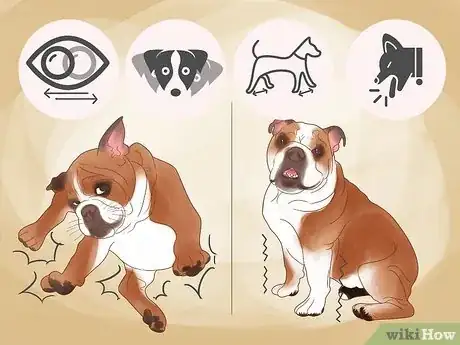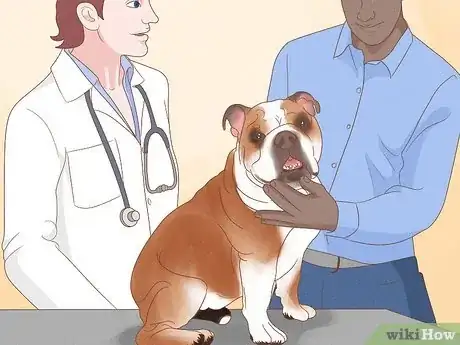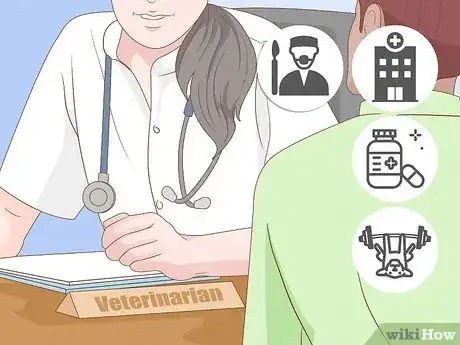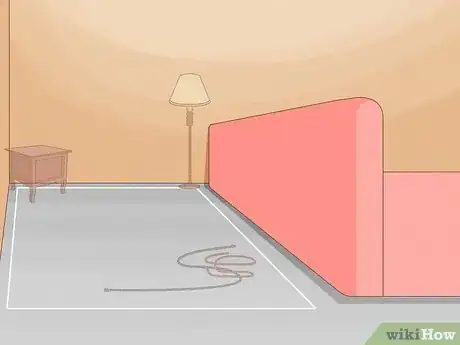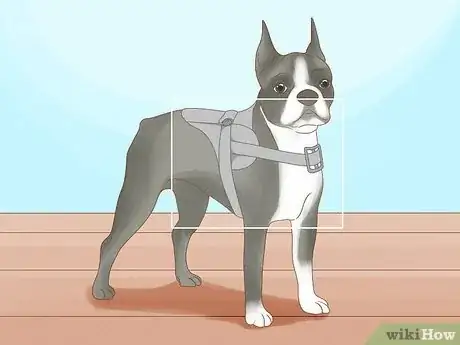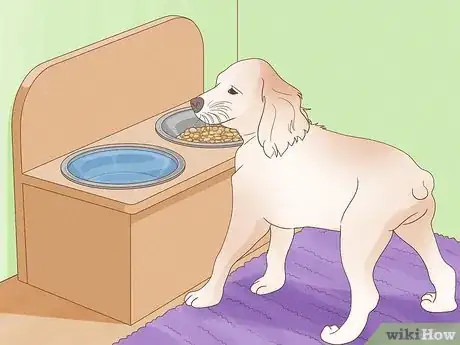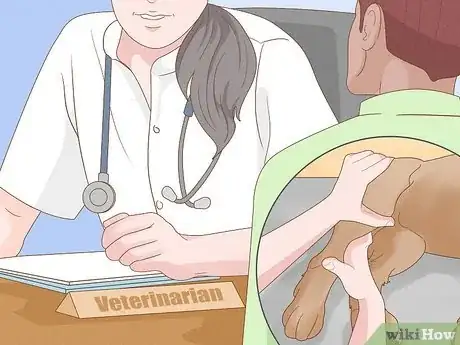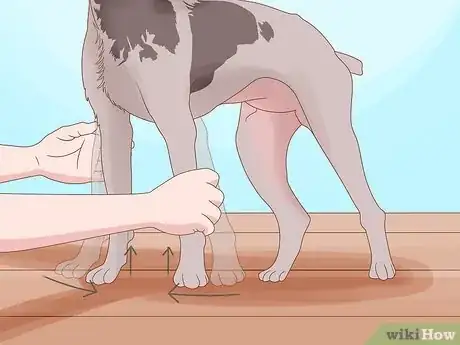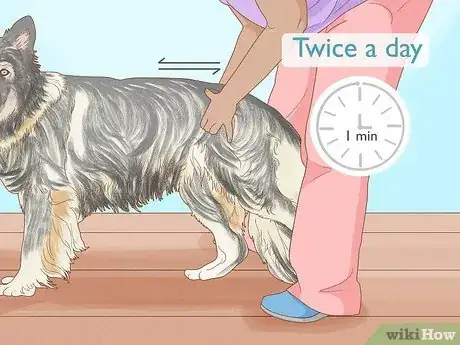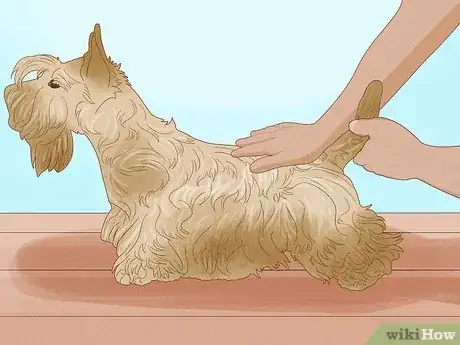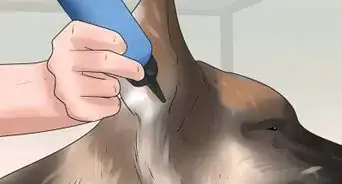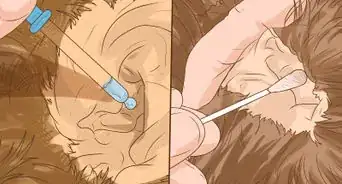This article was co-authored by Jamie Freyer, DVM and by wikiHow staff writer, Caroline Heiderscheit. Dr. Jamie Freyer is a Licensed Doctor of Veterinary Medicine based in Washington. With over ten years of experience in clinical practice and industry, she specializes in veterinary medicine and surgery, animal behavior, and animal genetics. Dr. Freyer holds a BS in Life Science from The University of Portland and a DVM from Oregon State University.
There are 15 references cited in this article, which can be found at the bottom of the page.
This article has been viewed 5,208 times.
When your dog suddenly starts stumbling and falling, it's a scary feeling for any loving owner. You want to comfort your dog and ease the symptoms, but how? Start by getting on the same page with your vet about a treatment plan. Then, you're free to get to work. To learn all of the very best ways you can comfort your dog with vertigo from home, read on.
Steps
Medical Treatment
-
1Look for signs that your dog is facing vestibular disease. When a dog suddenly faces balance issues and dizziness, owners may worry their pet is suffering from a seizure or stroke. Vestibular disease, though, is often the culprit. Watch out for symptoms like staggering, stumbling, or falling. Symptoms typically appear quickly and also include:[1]
- Back and forth or darting eye movements (also called nystagmus)
- Head tilting or head shaking
- Nausea or vomiting
- Rolling onto one side[2]
- Walking in circles
- Standing with a wide stance
-
2Take your dog to the vet for an official diagnosis. After your vet runs tests and examinations, wait to hear whether your dog is facing peripheral (inner ear) or central (brainstem and surrounding nerves) vestibular disease. Your dog’s diagnosis will probably include a cause for their illness. This could be anything from an ear infection to a head injury, so listen to your vet’s discovery.[3]
- Vestibular disease can also signal totally separate health issues, like hyperthyroidism.
- If your vet finds no cause, your dog will be diagnosed with idiopathic vestibular disease, or old dog’s vestibular disease. This is the most common diagnosis.[4]
Advertisement -
3Work with the vet to create a treatment plan for your dog. Your dog’s recovery will depend entirely on the cause or underlying health issue that lead to their vestibular disease. For idiopathic cases, listen to your vet's orders. Treatment will likely just be lots of rest, love, and patience. The prognosis for those cases is excellent. Other treatments include:[5]
- Treatments to fight the underlying cause—so for instance, antibiotics for an inner ear infection
- Hospitalization and IVF if your dog is struggling to eat and drink
- Sedatives in the case of serious balance issues
- Medication if your dog suffers from related nausea or anxiety
- An exercise plan which may include physical therapy, guided movement, etc.
- A warning against exercise and movement (if your dog suffers from infection or inflammation, for example)[6]
- Surgical treatment in the case of serious underlying issues
Home Care
-
1Create a safe, enclosed space for your dog. While they're facing balance issues, create a hazard-free area that allows them to move freely and safely (if they've been cleared for regular movement). Use a pen, a small room, or even your own furniture to create an enclosed area. Clear their space of anything dangerous that they could trip into, fall down, or fall over, like:[7]
- Staircases
- Sharp edges
- Floor clutter
- Small furniture
- Electrical cords
-
2Reduce your dog’s exposure to slippery floors. While your dog is facing balance issues, they're more likely to fall on hardwood or tile flooring. If your dog will be walking over a non-carpeted floor, lay down yoga mats, carpet runners, or rugs to offer them more traction.[8]
-
3Help your dog move with your guidance or a harness. If your dog is cleared to move freely but still has trouble, try holding them on each side of their body to keep them upright. Avoid holding your dog off of the ground though, because this will make it harder for them to reacclimate their senses and balance over time.[9]
- Additionally, buy your dog a harness or sling to help them move freely and practice balancing.
- Slings and harnesses can be found in pet stores or online shops. Ask your veterinarian for recommendations that suit your dog best.[10]
-
4Place food and water bowls in an easy-to-access location. It's important that your dog stays nourished while struggling with vestibular disease. Full-body balance issues may make it difficult for them to reach their bowls—or, depending on their illnesses' severity, even to lift their food to eat. Take steps to ensure that your dog is able to eat and drink freely.[11]
- Elevate your dog’s food and water bowls so that they don’t have to lower their neck to eat and drink.
- Place your dog’s food and water bowls against the wall and lean your dog against the wall as well. This will help them stay upright while they eat.[12]
- If they’re unable to move, bring their food and water bowls to them. Try hand feeding your dog if they’re struggling.[13]
-
5Make your dog’s food and water as appetizing as possible. Your dog is probably struggling with nausea, but it's important that they continue getting the nourishment they need. So, take steps to ensure their food and water are appealing and easy to digest.[14]
- Add chicken or veggie broth to your dog’s food or water to make them more appealing.
- Add warm water to their food. Moistening your dog’s chow will make it easier to chew (broth will achieve this as well).
- Roll wet, canned food into “meatballs” for an easy, hand-fed meal.
- Avoid their human-food favorites. Your nauseous dog may enjoy treats like this, but these foods will be hard to digest. This will worsen their illness.[15]
-
6Set up a soft, cozy bedding area for your dog. Your dog may feel uncomfortable, making it difficult for them to fall asleep. Make sure your dog has cozy, soft bedding while they struggle with vestibular disease. Your dog may also have a hard time rolling over, which could put them at risk for sores. If you’re able, flip your dog every four to six hours during the night.[16]
- Additionally, your dog may find it difficult to get up to use the bathroom at night.
- If they poop or pee in their bedding, clean it as soon as possible. Otherwise, they could suffer from painful urine scalding.
-
7Spend extra time with your dog to reduce their anxiety. To help your dog through vestibular disease, simply stay by their side. Speak to them in a gentle voice, pet them, and try to stay in the room with them, especially when they appear to be anxious. This isn’t to say that you need to put your life on pause entirely, but your presence can definitely be a source of comfort for your dog.[17]
- Depending on how your dog is feeling, they may also benefit from a food toy or puzzle to take their mind off of their balance issues and nausea.
- Additionally, if you worry that your dog is suffering from significant anxiety, speak to your vet about anti-anxiety medication.
At-Home Exercises
-
1Get clearance from your vet before trying at-home exercises with your dog. Over time, muscle weakness and limited joint movement could start to affect your immobile dog. With the approval of your vet, help your dog through strength building and coordination exercises to get them moving again.[18]
- Discuss whether or not your dog is cleared for movement given their vestibular disease's underlying cause.
- If your dog appears to be in pain at any point during an exercise, stop what you're doing immediately.
- If you feel uncomfortable walking your dog through exercises on your own, consult a physical therapist for help.
-
2Help your dog through a standing balance exercise. If your pup is slowly regaining the ability to stand, offer them extra support to speed up their journey. Using a harness, sling, or your hands, hold them upright in a standing position for just a few minutes at the start. Then, let them rest. As your dog gets more comfortable, keep adding more time.[19]
- If possible, maintain eye contact with your dog to encourage them on.
- Watch them closely during this exercise. If they begin to fall, make sure you're there to catch them.
-
3Work on your dog's ability to stand through a weight-shifting exercise. First, sit behind your dog and hold their sides firmly while they stand in front of you. Next, shift their weight back and forth for ~1 minute at a time. Perform this exercise twice a day, every day.[20]
-
4Hold your dog's tail while they walk to help improve balance. Make sure you grip near its behind (not near the tip of its tail). Use a stiff grip but don't constrict or squeeze your dog's tail. Rather than pulling the tail in either direction, gently hold it directly behind your dog while they practice balancing and walking in front of you.[21]
References
- ↑ http://veterinaryirelandjournal.com/images/pdf/nurse/nurse_jun_2016.pdf
- ↑ https://youtu.be/iqARREdpC3k?t=50
- ↑ https://www.mspca.org/angell_services/its-not-a-tumor-approach-to-vestibular-syndrome-in-old-dogs/
- ↑ https://veterinarypartner.vin.com/default.aspx?pid=19239&catId=102899&id=4951444
- ↑ https://vcahospitals.com/know-your-pet/vestibular-disease-in-dogs
- ↑ https://www.superbdog.com/vestibular-disease-in-dogs/
- ↑ http://veterinaryirelandjournal.com/images/pdf/nurse/nurse_jun_2016.pdf
- ↑ https://youtu.be/NRR2qr6Ce_g?t=57
- ↑ https://vestibular.org/article/diagnosis-treatment/types-of-vestibular-disorders/pets-vestibular-dysfunction/
- ↑ https://youtu.be/NRR2qr6Ce_g?t=324
- ↑ https://youtu.be/NRR2qr6Ce_g?t=305
- ↑ https://www.superbdog.com/vestibular-disease-in-dogs/
- ↑ https://www.pdsa.org.uk/pet-help-and-advice/pet-health-hub/conditions/vestibular-disease-in-dogs
- ↑ https://youtu.be/NRR2qr6Ce_g?t=241
- ↑ https://www.superbdog.com/vestibular-disease-in-dogs/
- ↑ https://youtu.be/NRR2qr6Ce_g?t=135
- ↑ https://youtu.be/NRR2qr6Ce_g?t=322
- ↑ https://www.superbdog.com/vestibular-disease-in-dogs/
- ↑ https://www.superbdog.com/vestibular-disease-in-dogs/
- ↑ https://www.superbdog.com/vestibular-disease-in-dogs/
- ↑ https://www.superbdog.com/vestibular-disease-in-dogs/
